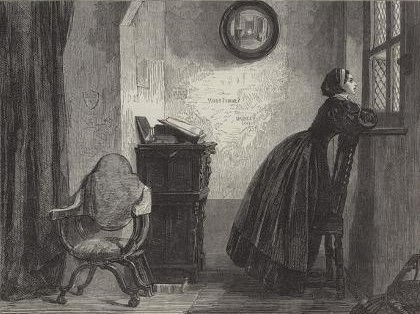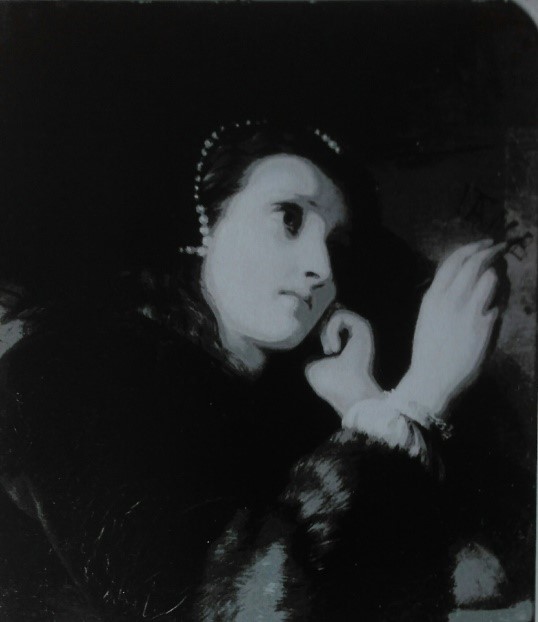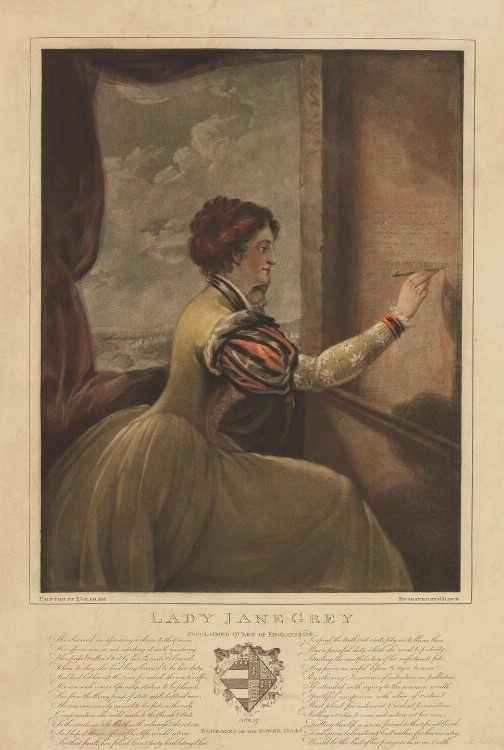After watching the recent channel 5 television programme ‘inside the Tower of London’ that focused on the story of Lady Jane Grey, I noted that the famous Dudley carvings on the walls of the Beauchamp Tower were discussed as part of the programme. Not discussed within this interesting documentary were the two other carvings associated with Jane’s story also carved into the walls of the same room.
In 2018, I finally got the chance to visit the Tower of London as an adult. Upon seeing the two small carvings in the Beauchamp Tower in person, I was instantly struck with an air of sadness. To me, these two carvings symbolised so much of the history that had interested me for most of my life, and I knew so little about them. Over the years, my interest in the story of Lady Jane Grey has led me to read a lot of printed material about her. I was aware of the survival of the carvings, though I had read very little about the history that surrounds them.

My initial thought had been that the inscriptions had always been known about and that the tradition that they were associated with the story of Jane Grey had travelled down through the centuries. This in turn prompted me to dig a little deeper in the hope of gaining a better understanding.
The aim of this article is to establish what is known about the two IANE inscriptions and to document some details regarding the history of these important artefacts, as so little has been written about them since their discovery.


During my research for this article I have been unable to locate any reference regarding the two carvings of Jane’s name prior to the eighteenth century. According to John Foxe’s Acts and Monuments, first published in 1563, Jane was supposed to have written the following two verses into the wall of her apartment with the use of a hair pin.
“Do never think its strange,
Though now I have misfortune,
For if that fortune change,
The same to thee nay happen.”
“If God do help thee,
Hate shall not hurt thee;
If God do fail thee,
Then shall not labour prevail thee.”
Fox makes no mention of any other carvings showing Jane’s name within the walls of the Tower of London in his book. Various searches over the years have been made at the Tower in the hope of locating the above inscriptions noted by Fox, but the house in which Jane is recorded as being held was demolished in the eighteenth century. It was replaced with the existing building today which stands between the Queens House and the Beauchamp Tower.[1]
The two inscriptions were first discovered in 1796. During this period, the upper room of the Beauchamp Tower was being converted for the use of officers of the garrison. Prior to this, the room had been used for domestic use, and the walls had been plastered over and painted, thus eliminating any traces of earlier inhabitants.
During the renovations, the plaster was removed from the walls, which in turn revealed a large number of inscriptions etched into the stonework. On discovery of these, it was immediately noted that a lot of the carvings where associated with prominent figures in history who had been imprisoned within this room at the tower.
Reverend John Brand, Secretary to the Society of Antiquaries, was the first to discuss the carvings in a meeting held on 17th November 1796. Notes from the meeting were published in the Archaeologia Journal in 1800, and this also gave us our first visual view of the inscriptions found.

Within this meeting, Brand discussed the discovery of the inscriptions, referring to them as ‘undoubted autographs made at different periods.’ Brand was also noted to firmly claim that the IANE inscription was made by Lady Jane Grey herself, reporting that this had been done ‘as a statement that not even the horrors of prison would force her to relinquish her title as queen.’[2] This in turn led to a number of artists creating images of Jane either making the inscription herself or depicted within the room containing an inscription of her name.

It is not known how or why Brand had come to this conclusion as the exact place in which Jane was housed when prisoner at the Tower was documented within the Chronical of Queen Jane and of Two Years of Queen Mary. This book was thought to have been written by a resident at the Tower of London who notes that Jane was imprisoned in Partridge’s House and not the Beauchamp Tower. [3]
This claim was eventually corrected with the publication of a book in 1825 by John Bayley. In this, Bayley discussed the fact that Lady Jane herself was imprisoned in the house of the Gentleman Gaoler on Tower Green, also known as Partridge’s House. He reports that due to this, the inscriptions could not have been made by her hand, noting that it’s highly unlikely that Jane would have been allowed to spend time in the prison cell allotted to her husband. Bayley then suggests that the inscriptions were actually made by Guildford Dudley himself or one of his brothers in memory or honour of Jane Grey.[4]
It is
Bayley’s theory that sticks today. It
could be argued that if the inscription was made by one of the Dudley brothers,
then it might not in fact represent Lady Jane Grey but their mother, who was
also called Jane Dudley. The face that
two inscription of the same name survives may represent the two Jane’s within
the brothers lives, though it is up to the individual viewer to decide.
[1] Treasures of the Tower Inscription, Her Majesty’s Stationary Office, page 14
[2] Brand. John, An Account of The Inscriptions Discovered on The Walls of An Apartment in the Tower of London, Archaeologia, XIII, Page 68-91
[3] Nichols, J. G, The Chronicle of Queen Jane and of Two Years of Queen Mary and Especially of the Rebellion of Sir Thomas Wyatt, Written by a Resident in the Tower of London, Llanerch Publishers, 1850, page.25
[4] Bayley, John, History and Antiquities of the Tower of London, 1825, page.162



Some historian, I forget who, suggested that the ‘Jane’ carvings were done by the Duke of Northumberland in honor of his wife Jane Guilford.
The carvings are from the Tudor period as the letter ‘A’ looks like that in the ‘HA’ carvings (celebrating Henry VIII and Anne Boleyn) in King’s College Cambridge.
See: http://www.lucychurchill.com/KingsCollegeChapelChoirScreen.php
Another possible Jane is Jane Parker, Lady Rochford, executed at the Tower in 1542.
Roland H.
LikeLike